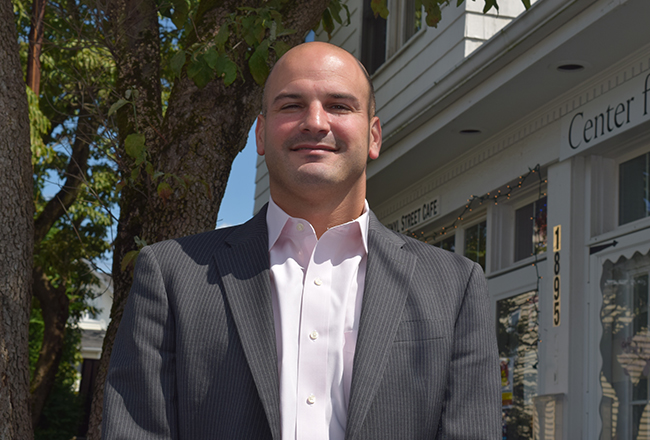 Our world is changing. People are rising up to create that change. Hashtags such as #Keepfamiliestogether and #ItsUnAmerican helped to drive the reversal of an executive order. As social activists band together for change, so too do climate activists, building awareness that industrial processes and human consumption have caused extreme storms and rising temperatures. Everyday citizens are engaged in debating and defending their opinions of the U.S. political environment like never before. These citizens are our customers, and our customers are demanding change. Just as age-old business practices are no longer relevant as digitization and automation change the ways businesses manufacture, deliver and market goods and services, the ways we think about our businesses must change too.
Our world is changing. People are rising up to create that change. Hashtags such as #Keepfamiliestogether and #ItsUnAmerican helped to drive the reversal of an executive order. As social activists band together for change, so too do climate activists, building awareness that industrial processes and human consumption have caused extreme storms and rising temperatures. Everyday citizens are engaged in debating and defending their opinions of the U.S. political environment like never before. These citizens are our customers, and our customers are demanding change. Just as age-old business practices are no longer relevant as digitization and automation change the ways businesses manufacture, deliver and market goods and services, the ways we think about our businesses must change too.
Businesses now require a thoughtfulness that is world-first, not we-first. Our companies must recognize that our customers will rise against us if they do not agree with our ways. Customers now care more about the environment, the climate and limiting waste. They want a healthy planet and are responding to businesses that are mindful of the well-being of the world and all of its inhabitants.
Now is the time to let sustainable thinking lead the decisions we make and begin to measure success in ways other than by our bottom lines.
Here are three ways of sustainable thinking that business professionals can implement for leading the way towards a sustainable future for all:
Systems Thinking
All businesses are systems with their people, places and things wholly interconnected. Thoughtful analysis of these interconnections and their effects on outside systems is known as systems thinking.
In business, systems thinkers understand the connections between all parts of their company and its supply chains. They know how their particular piece of the puzzle works with other puzzle pieces within their company, as well as how their company fits into larger regional, national and global markets and systems. Systems thinkers look at every component of their business and how it will affect other systems.
For instance, a systems thinker will consider the environmental repercussions of all material sourcing decisions made. A systems thinker may reconsider switching to a lower-priced synthetic material because they know the lower-cost material created from a petroleum byproduct and the extraction of petroleum is harmful to our earth. Systems thinkers understand the production of synthetic materials release gases into the atmosphere during production, causes poor air quality and know that what pollutes the air also poisons our water and all living creatures on the planet.
Through systems thinking, corporate cultures can anticipate the effects of social inequality, declining natural resources, and climate change. Systems thinking generates resiliency and supports equity, and businesses that understand systems create and benefit from innovative, responsible practices.
Systems thinkers measure success by triumph in other systems as well as in their own. Cleaner air and water in overseas countries where your first-tier suppliers are located is considered beneficial. Systems thinking creates resilient corporate cultures, who compassionately understand the complexities of the many systems in which they belong. They can use that complexity advantageously, creating success for all. Moreover, systems thinkers are rewarded as people within those other systems appreciate their actions and spread the word. Systems thinking creates a positive buzz around a company like no other.
Place-Based Thinking
This type of thinking considers the community in which a business is based. When a company employs place-based thinking it considers the consequences of its practices and how those practices may impact the quality of life for the inhabitants of its community. The company commits to being a vibrant part of its community and not to harm its community with its practices. Place-based thinkers carefully and critically evaluate the well-being of the places in which their business operates and seek to bring resources to improve the quality of life for all in those places.
For instance, a place-based thinker will reconsider switching from a local existing higher-cost supplier to an out-of-region lower-cost supplier, as they understand the direct effects to the local company, community, and citizenry. A place-based thinker will consider that a local company with an active regional business positively affects their employees, who will, in turn, have more work hours and therefore more spending dollars to use for discretionary purchases to buy within their communities.
Place-based thinkers see their business and their community in a closed loop system that sustains the well-being of both, and values and nurtures the local community in ways that companies focused on labor and resources in distant places cannot. No longer vulnerable to the whims of tariffs and trade negotiations, businesses that build a genuine connection to the local community create resilience, pride, and loyalty from the those in the local community. Also, nothing beats a loyal base.
Story Thinking
Combining systems and place-based thinking gives businesses advantages and insights into the people and the resources of the places in which they operate. They build symbiotic rather than parasitic relationships that are mutually beneficial, but these responsible and harmonious actions will not alone bring success. Businesses must engage and educate customers on their new ways of thinking by utilizing the power of the story.
Story thinking requires living and telling a story that is different from what has previously been said. Without realizing, businesses have been telling exploitive stories, which have given wastefulness, polluting practices and low wages validity. Activities that disrupt those exploitative stories and live and tell new stories send strong signals for change.
Story thinking involves discussing each responsible business decision and detail. Customers enjoy being part of new journeys through what they buy, eat, drive, wear, and use. Think about unique ways to take them on those journeys with stories of sustainability. Stories help your customers connect with your brand. Most importantly, they will share your story.
Craft your story and detail your systems and place-based decision-making processes. Explain your product or service from concept through delivery to their homes or offices. Discuss the materials you select, where they came from, why you chose them. Tell your customer who made your product and how you support them. Describe how you package, ship, think, and illustrate how you care about a sustainable future. Shoppers are paying close attention to these stories; they”™re not only looking at price tags.
Tell the unique ways that your business thinks and operates and customers will take note of the story and appreciate your nurturing ways and be inspired to support you. Stories are critical to customer engagement.
These ways of sustainable thinking will transform your company into an earth-friendly company. Implement new thinking into everything you do from concept creation, development, sourcing, manufacturing, and shipping, and celebrate your initiatives by telling these stories on boxes, buses, labels, and Instagram pages. Let the world know your company is concerned about more than profit. Let your customers know you”™re part of the solution ”” not the problem. In turn, your bottom line will increase. Systems thinking, place-based thinking and story thinking are forward-thinking. So adjust your thinking and create new practices centered in an awareness of the world and all the people in it.
Sherie McClam is an associate professor at Manhattanville College in Purchase where she developed an Education for Sustainability Advanced Certificate Program committed to creating educators and leaders for a sustainable future.
Andrea Kennedy is founder of Fashiondex.com, a sustainable fashion consultant, and an assistant professor at LIM College in New York. She is also a proud graduate of McClam”™s Program.





















